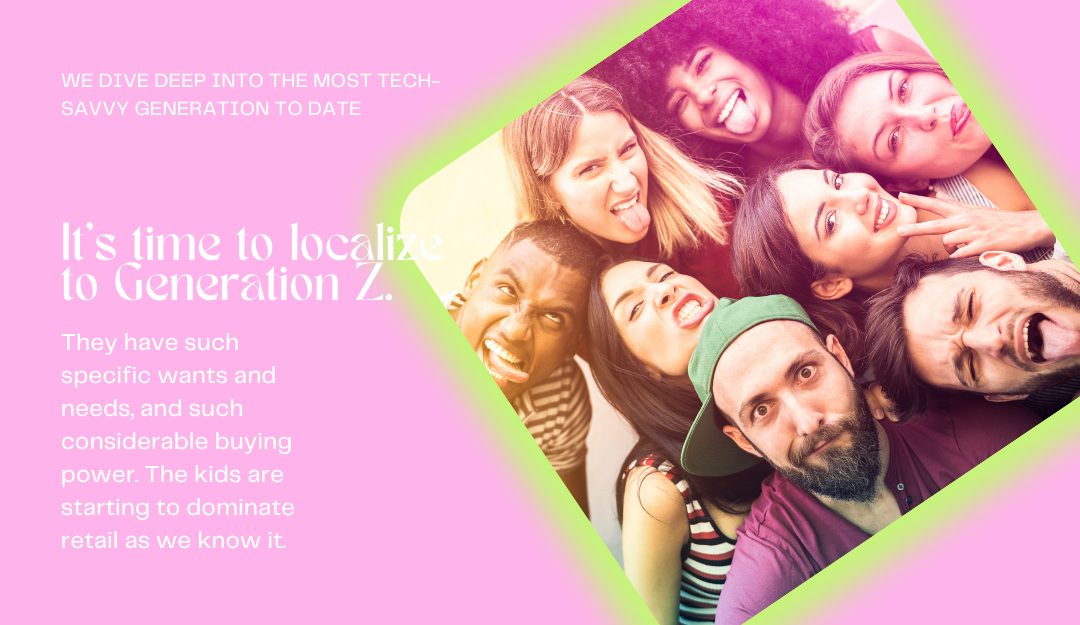Gen Z. They’re all everybody can talk about these days. Merriam Webster defines them as “the generation of people born in the late 1990s and early 2000s” (most studies put them between 1997 and 2010). They’re often stereotyped as young people attached to their phones and breaking into TikTok dances at random. We often talk about how crucial it is to localize to different cultures – but it is just as crucial to localize to different generations. After all, Insider Intelligence anticipates that by 2025, Gen Z will make up more than 85% of the population. Any savvy Amazon seller needs to consider this population’s specific needs, and start speaking to them in a language they understand.
Who is Gen Z? A Snapshot of the Centennials
Defining this Centennial generation might be easier if we compare them vs. millennials. According to the WGU Blog on Gen Z and the Workplace, there are some commonalities and some differences. Both generations desire to create or find meaning. They are motivated to contribute to the world. They’re well educated, and welcome cultural diversity. They also desire their own personalized experience.
Products that would resonate with both target markets would include eco-friendly products, unique artisanal products, personalized print-on-demand products, and the like.
Generation Z kids and millennials aren’t identical, though. Gen Z is more independent, entrepreneurial, and communicative. They’re quite competitive, and are motivated by security. In fact, they’re known to prioritize financial security over “personal fulfillment.” They value companies and brands whose values align with theirs, and who are interested in making a global impact.
Their spending power is considerable. They suffered financial losses during the pandemic, as did we all, but out of all the generations, they seem to have recovered best, according to HubSpot. A 5WPR report shows that Gen Z spends 43 minutes more on online shopping than they did pre-Covid-19. They seem to enjoy patronizing smaller brands as well. This is better news for the small Amazon seller operating a family-run business in Small Town U.S.A., and maybe a little less good for the massive aggregator, which may espouse corporate values that don’t always resonate with this “woke” generation.
The Impact of TikTok on Keywords
If a Centennial is interested in a product, they’re likely to research it on YouTube. Then, in order, they’re on Instagram, Snapchat, and TikTok. That being said, trends show that TikTok usage jumped from 50% to 63% year-on-year, whereas Instagram showed a decline (but not enough to unseat it from first place_ – and Snapchat stayed stagnant. According to eMarketer though, the Facebook-owned social media platform though is putting up a winning fight with InstagramReels, so “Insta” doesn’t seem to be dying any time soon.
To quote a recent study by Deloitte, “…reworking of the English language is the beginning of Gen Z’s influence.” To quote Jana, “Gen Z consume ads on TikTok and they’ll buy what’s trending. They dictate the trends, which will impact which keywords start doing well on Amazon. If something is trending on TikTok, keywords are likely to follow suit.”
What Can You Do to Localize to This Demographic?
Diversity is Key
The same Deloitte study mentions how crucial diversity is to Gen Z – “not just isolated to race and gender, but also related to identity and orientation.” Used to be, sellers chose models for their photos that best represented a “neutral demographic” – usually a blonde woman who was attractive but not extraordinary, with a pleasant smile. A model like that was easy to localize to Europe, America, and Australia. Sometimes the same model would convert an Asian audience, depending on the product. But with Gen Z making such a huge impact, it looks like more diversity is expected in a brand’s marketing. If you’re selling to a predominantly Gen Z market – for example, tech products and ecofriendly accessories – consider including nonbinary models in your infographics as well.
Short, Cute, and Simple Sells Best
The A.List Daily study showed that Gen Z value content that is entertaining, fun, or funny. They like being encouraged to express themselves. With recent changes in Amazon’s user experience, Gen Z customers can now scroll your image feed from the search page alone – which means your images need to stand out all the more now, and be entertaining, fun, and easily digested. Don’t make that A+ too long and wordy if you’re selling kawaii phone cases; you’ll lose out on conversion. Pictet calls this type of content “snackable.” It’s crucial to adapt your content to their (rumored) 8 second attention span. The mixture of text, images, and video works very well – so don’t neglect on that video in your image array.
Listen Well to Their Needs
To quote Insider Intelligence:
After ignoring the digital revolution and millennial buyers for too long, retailers and brands have spent the last decade trying to catch up to millennials’ interests and habits—so it’s critical for them to get ahead of Gen Z’s tendency to be online at all times, and make sure to meet this generation’s digital expectations.
This is the largest generation in American history, and embraces cultural diversity and inclusion more than any other generation before it. Ask yourself, as an Amazon entrepreneur: how can you answer their unique needs? This generation will have considerable spending power by 2026. In fact, many of them already invest in cryptocurrencies. They’re tech-savvy and mobile-led – and they have very short attention spans. They care about the planet, about each other, and have strong values.
Should We Localize to Gen Z?
As we’ve established here, this generation learns on social media – and they use their mobile phones to consume social more than laptops. Here are some tips to market to Gen Z:
- Focus on the sustainability and/or social consciousness of your product
- Speak to the values of your brand, especially if they resonate with Gen Z’s values
- Include cultural, racial, and gender diversity in your marketing
- Most conversions are likely to be done on mobile, so keep your content mobile-optimized
- Take your marketing off Amazon. External traffic is key to conversions – if your target market is Gen Z, use TikTok, YouTube, and Instagram as platforms for your content.
Here’s a big question. SHOULD YOU LOCALIZE ON A MICRO LEVEL? Is the Spanish Gen Z customer the same as the American Gen Z customer? Perhaps the Japanese Gen Z have different expectations from Middle Eastern ones? So far, there’s no data that goes this deep. What do you guys think? What are the Gen Z kids like in your part of the world? Help us out so we can refine our localization practices even better!

